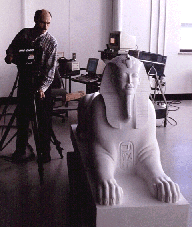|
|

| Français | Contact Us | Help | Search | Canada Site | ||||
| Home | About Us | Publications | Careers | NRC Site | ||||
| Research | People | Collaborations | Locations | What's New | ||||
| Printable version |
Replication for the Mysteries of Egypt Exhibition at the Canadian Museum of Civilization
1998 - Gatineau, Canada
The 3D image data can be transferred into CAD models for fabricating accurate 1:1 or scale replicas using modern replication technologies such as stereo lithography.
There are four important advantages to this approach for museum and heritage applications.
- Unlike direct casting, the object is not touched or damaged during scanning.
- Scale replicas made using the 3D model data are much closer or truer representations of the shape of the object than those copied by hand.
- The data can be formatted to machine the replica directly (positive mode) or to make a mold (negative or inverse image).
- Similar to print making, the artist or museum owning rights to the object, can make scale replicas of works for sale as limited edition replicas.
As an example, during the Mysteries of Egypt Exhibition, the Canadian Museum of Civilization (CMC), used the Large Volume Laser Scanner to scan a model of a sphinx in order to prepare smaller replicas for sale in the Museum shop during the exhibition.

Figure 1: The replicas were prepared using the 3D model data of a large model of a sphinx scanned using the Large Volume Laser Scanner.

Figure 2: Scale replicas of a sphinx were sold in the Museum shop during the exhibition. The original sphinx measured 2 m in length while the scale replicas were 28 cm and 11 cm in length.

Date Published: 2006-02-10
|
Top of Page | |
